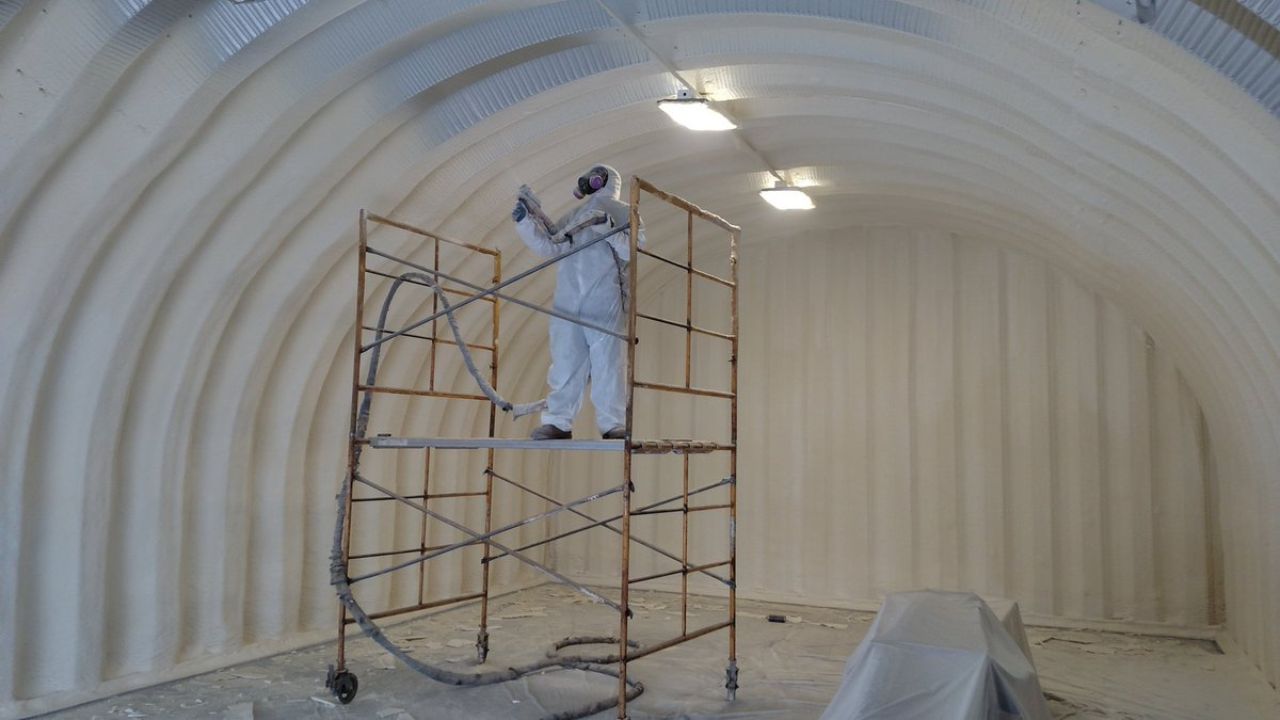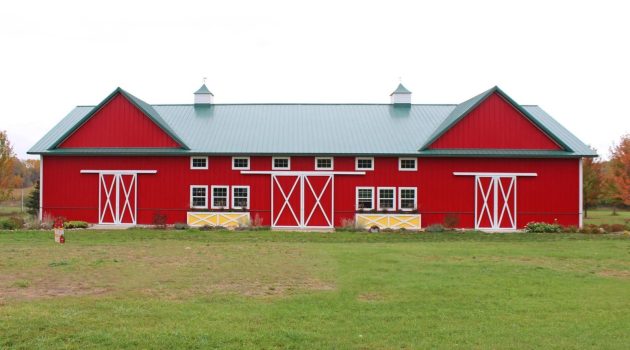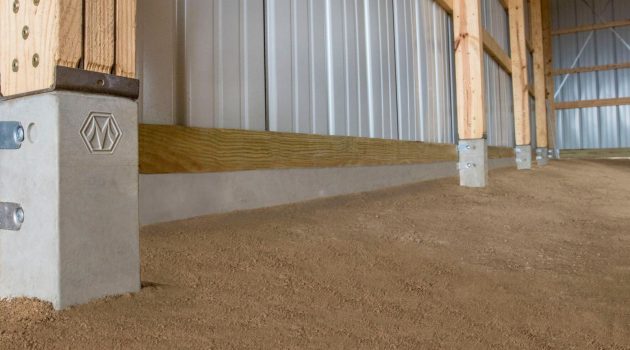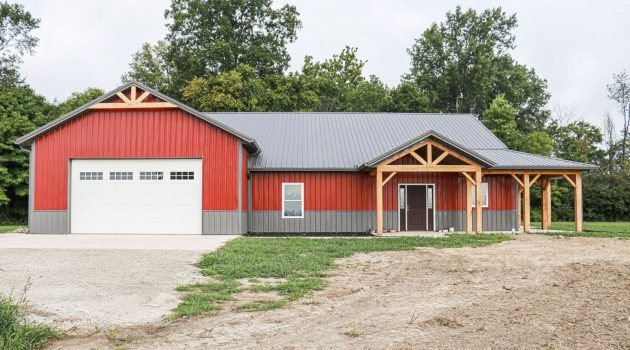Insulating a Quonset hut is essential to ensure your custom home remains comfortable throughout the year.
As these unique metal buildings are known for arch walls and steel construction, finding the right insulation can be daunting.
But no worries, with the proper guidance, you can make the best choice for your Quonset hut insulation.
The primary reason to insulate your Quonset hut is to maintain a stable temperature indoors.
Without insulation, these metal structures can become too cold in the winter as the outside air cools, and the metal framework does the same.
Selecting the best insulation for your Quonset hut will depend on your specific needs and climate, so let’s explore the options available.
There are various insulation options for your Quonset hut, each with benefits and drawbacks.
From high R-value materials that prevent heat transfer to vapor retarders and acoustic benefits, the choices are vast.
Finding the right fit for your project to maximize efficiency and provide a comfortable living space for years to come is crucial.
1. Benefits of Insulating a Quonset Hut
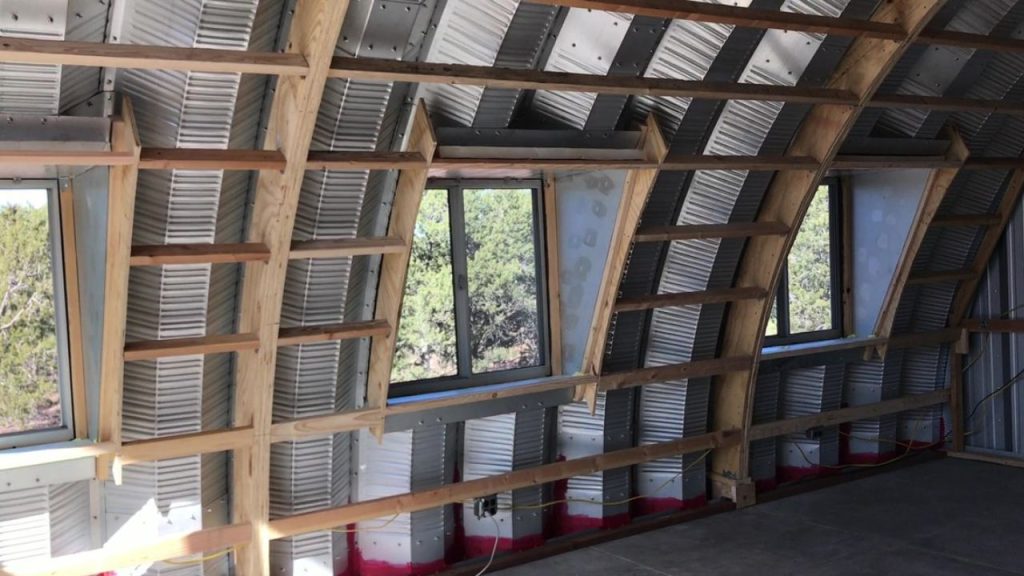
Insulating your Quonset hut has various advantages that are both practical and cost-effective.
Adding insulation to your hut can create a comfortable living space with controlled temperature, noise reduction, and protection from moisture.
One primary benefit of insulating your Quonset hut is enhanced temperature control.
Insulation helps regulate the interior temperature, ensuring that your hut stays warm in the winter and cool in the summer.
This way, you can save on energy costs associated with heating and cooling systems.
Another advantage of insulation is noise reduction.
Insulating materials, especially those with high R-value, act as an excellent sound barrier, minimizing external and internal noise volume.
This feature is particularly helpful if your hut is near a busy road or you plan to use the space for music practice or other noisy activities.
Additionally, insulation materials offer protection from moisture and condensation.
A well-insulated Quonset hut can decrease moisture build-up by reducing condensation on metal surfaces.
Waterproof insulation options, such as polymer-based materials, are particularly effective in preventing water infiltration and preserving the structural integrity of your hut.
Insulation is durable and easy to install and can also save you time and money in the long run.
Investing in high-quality insulation materials can prolong your Quonset hut’s lifespan and avoid costly repairs or replacements due to weather or temperature-related damage.
2. Coping with Problems and Challenges
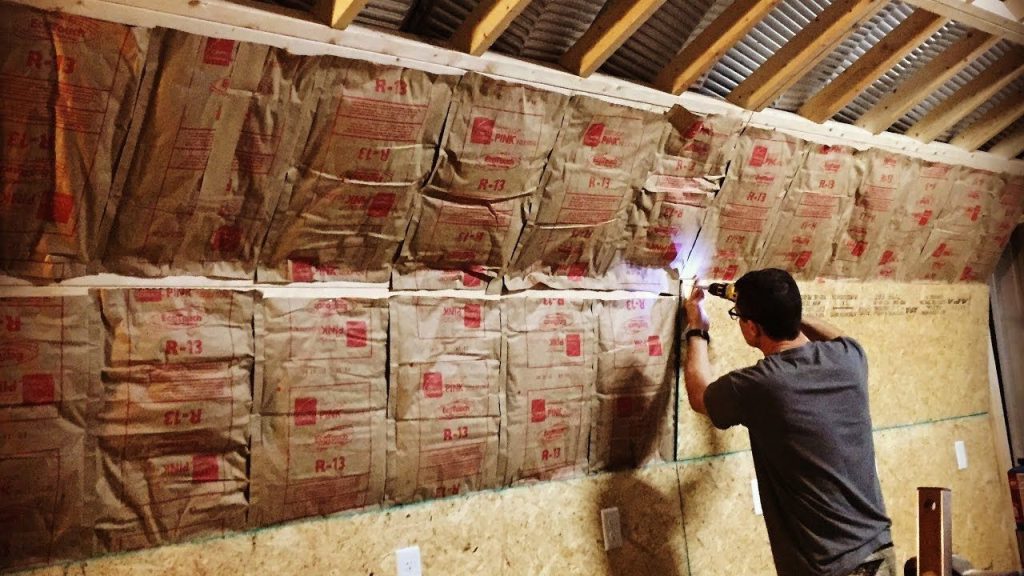
One of the most common issues when insulating a Quonset hut is mold and mildew buildup due to moisture and condensation.
You can reduce this problem by using insulation materials that provide a proper vapor barrier, like closed-cell spray foam.
This will help prevent moisture from getting trapped inside the insulation and create an environment where mold and mildew can thrive.
Condensation issues might arise due to temperature differences between the metal exterior and the hut’s interior.
To minimize condensation, ensure that your insulation is installed correctly and forms a continuous layer, leaving no gaps or spaces where moist air can accumulate.
Wearing a respirator suit during the installation process is important for your health, as it protects you from inhaling harmful particles that insulation materials can release.
Also, wear protective gloves to avoid getting messy or damaging insulation.
Keep an eye out for damp spots as well. Dampness in a Quonset hut can lead to corrosion and rust on the metal frame and walls.
To prevent this, make sure the insulation material you use is moisture-resistant, and consider using a dehumidifier to maintain a comfortable environment inside the hut.
Lastly, always ensure proper ventilation in your Quonset hut to eliminate mold and mildew growth and keep moisture levels in check.
3. Other Uses of Insulated Quonset Huts
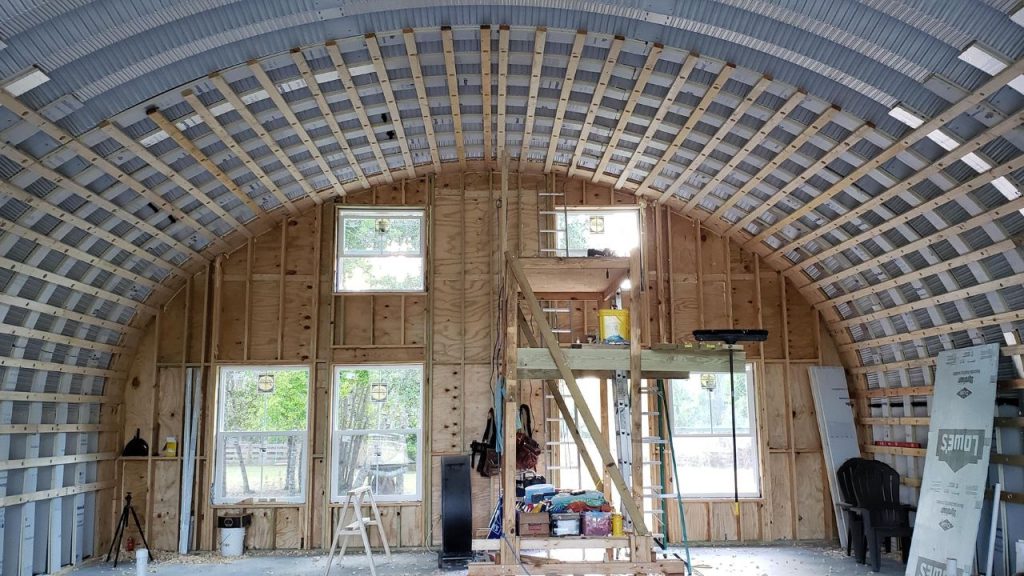
Insulated Quonset huts can be more than just functional storage or industrial applications structures.
With their unique, versatile design and efficient insulation, they can be transformed into various spaces that cater to your needs and preferences.
Here are some alternative uses of insulated Quonset huts:
- Homes: Insulated Quonset huts make for excellent living spaces, thanks to their energy efficiency and comfortable interiors. You can turn your hut into a cozy home with all the necessary amenities while saving on heating and cooling expenses.
- Businesses: These structures can also serve as cost-effective solutions for business requirements. Whether you need an office, a retail store, or a workshop, an insulated Quonset hut can provide the ideal space while keeping your utility bills in check.
- Workshops: If you’re into woodworking, metalworking, or any other creative pursuits, an insulated Quonset hut can be your dream workshop. It offers ample space, a stable temperature, and an environment that minimizes condensation, keeping your tools and materials in good condition.
- Man Caves: Looking for a getaway spot within your property? Transform your insulated Quonset hut into the ultimate man cave, where you can relax, entertain, or indulge in your favorite hobbies without disturbing other household members.
- Relief Shelters: In times of crisis, insulated Quonset huts can serve as temporary relief shelters for displaced people. They can quickly be set up, provide adequate protection from the elements, and maintain a comfortable internal temperature for occupants.
4. Specialized Insulation for Quonset Structures
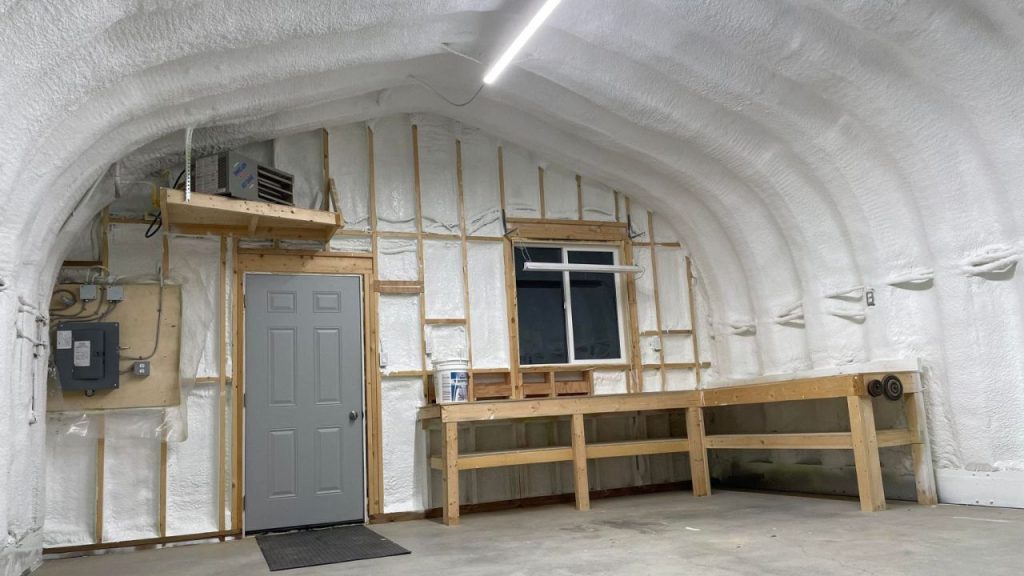
When insulating your Quonset hut, choosing the right materials and techniques is essential to ensure maximum comfort and energy efficiency.
Quonset structures, also called arch-walled metal buildings, have unique characteristics requiring specialized insulation solutions.
First, consider insulation kits specifically designed for Quonset huts. These kits consider the curved shape of the walls and roof, ensuring a secure and seamless fit.
Most kits provide insulation for the arch roof/wall and end wall insulation, ensuring your entire structure is well-insulated.
Since Quonset huts are made of sheet metal, they can be particularly vulnerable to temperature fluctuations and solar radiation.
Insulating the arch roof and walls can help reduce heat transfer, ensuring your Quonset hut remains cooler in the summer and warmer in the winter.
When choosing arch-walled metal building insulation, consider materials with a high R-value. This is the measure of a material’s resistance to heat flow.
The higher the R-value, the better the insulation.
Some common insulation materials for Quonset huts include fiberglass, reflective foil, and spray foam.
Each type has advantages and drawbacks, so you must consider cost, ease of installation, and potential environmental impact.
Some key features to consider for Quonset hut insulation include:
- High R-value for better thermal resistance
- Moisture and vapor resistance to prevent condensation and mold growth
- Proper fit for the curved shape of the walls and roof
You can enjoy a comfortable, energy-efficient space year-round by choosing the right insulation for your Quonset hut.
Consult a professional installer or manufacturer if you have questions regarding the best insulation choice for your specific structure.
Frequently Asked Questions
What is the most effective way to insulate a Quonset hut?
There are two main types of insulation for Quonset huts: batten and spray foam. Batten insulation is made of mineral fiber consisting of rock wool or processed fiberglass, and it’s typically used on floors, ceilings, and inside walls. Spray foam insulation is applied directly to the interior surface of the hut, forming an insulating barrier. Both options can be effective, but it’s important to consider your specific needs, climate, and budget when choosing the right insulation for your Quonset hut.
How much does it typically cost to insulate a Quonset hut?
The cost to insulate a Quonset hut depends on the size of the building, the type of insulation you choose, and labor costs in your area. Batten insulation is generally less expensive than spray foam insulation. On average, you can spend around $1.50 to $3.00 per square foot for batten insulation and $2.50 to $6.00 per square foot for spray foam insulation. Always get multiple quotes from insulation contractors to ensure you’re getting a fair price.
Can I use Prodex insulation for my Quonset hut?
Yes, Prodex insulation is a suitable option for Quonset huts. Prodex is a type of reflective insulation that helps reduce heat transfer by reflecting radiant heat away from your building. This type of insulation can be an effective addition to your Quonset hut, especially in hot climates where solar heat gain is a concern. However, Prodex insulation does not substitute traditional insulation materials like batten or spray foam.
What are some common issues with Quonset hut insulation?
Some common problems that can arise with Quonset hut insulation are improper installation, inadequate insulation, and condensation issues. Insufficient insulation can lead to higher energy costs and reduced comfort, while poorly installed insulation may result in gaps or uneven coverage, reducing its effectiveness. Condensation can also be a concern, as it can lead to rust and corrosion of the steel structure, mold, and mildew growth.
How do I prevent condensation in my Quonset hut?
To prevent condensation in your Quonset hut, you’ll need to create a proper vapor barrier and ensure adequate ventilation. This can be achieved by installing an adequate layer of insulation with a vapor barrier facing the interior side of the building. Additionally, you should install vents near the roof and base of your hut to promote air circulation and reduce humidity levels inside the building.
Are there any unique considerations when insulating a Quonset hut house?
When insulating a Quonset hut house, paying attention to the curved walls and roof is important, as this unique shape can make it challenging to install insulation evenly. Spray foam insulation is an excellent option, as it can be applied directly to the curved surface and expands to fill any gaps or voids. Additionally, you’ll want to ensure that your insulation meets the appropriate R-values for your climate and intended use of the building to maximize energy efficiency and comfort.
